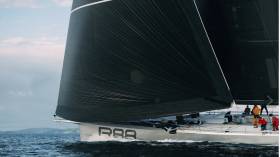Displaying items by tag: Rambler88
Rambler 88 On Track For New Round Ireland Monohull Record
Day 3 1200hrs You lose a major record on one side of the Atlantic one day, so you simply establish a new one on the other side of the ocean the next afternoon. That’s the way it is with the irrepressible George David of Rambler 88 writes W M Nixon
Yesterday in Bermuda, Jim and Kristy Clark’s 100ft Comanche, skippered by Kenny Read with the legendary Stan Honey calling the tactical and weather shots, knocked a clear five hours off the course record for the classic biennial Newport-Bermuda Race. That record had been established in the race of 2012 by George David with his veteran 90ft Rambler, to which he had returned for his campaigning after his newer Rambler 100 had exited the David racing scene when her keel broke off in the 2011 Fastnet Race.
Rambler 100 has since re-appeared under new ownership as Investec Loyal in Australia. But even while he was campaigning again in Rambler 90, George David and designer Juan K were planning the perfect boat, Rambler 88, and for two years and more now, she has been an adornment and a force to be reckoned with on the international offshore racing scene.
But with the keel crunch of 2011, George David felt he still had issues for his new Rambler 88 both with the Fastnet Race itself – which he duly completed in 2015, but it wasn’t a big boat race – and with Ireland too, issues which could best be dealt with by a full-hearted participation in the Volvo Round Ireland Race 2016.
Full-hearted with George David makes most other efforts look faint-hearted. For as of 1215hrs today, Rambler 88 is coming down the Irish Sea with just 46 miles to go to the finish at Wicklow, she’s on course in a moderate westerly breeze with 15 knots on the clock, and with the south-going ebb starting to make early in the afternoon from Rockabill southwards, she is well on track to beat Jean-Philippe Chomette’s 2006 open mono-hull record of 2 days 9 hrs and 41 minutes, while at the same time completely blowing away Mike Slade’s race course of 2 days 17 hours and 48 minutes set in the Round Ireland Race of 2008 by the 100ft Leopard.
The only thing missed is the two day record, which will expire with Rambler still at sea at 1300hrs today. But in the bigger picture, Rambler’s achievement is put into an even grander perspective when it’s remembered that she is also currently leading IRC overall in the Volvo Round Ireland Race. While they may make spectacular appearance to take line honours in major events it’s extremely unusual for the stratospherically-rated canting keel maxis to win on IRC handicap, so if Rambler 88 manages it this time round, we’ll have history made at least three times over.
Meanwhile in Bermuda Kenny Read has been enthusing how it was Stan Honey’s advice which enabled Caomanche to show her full potential and establish this new Bermuda Race record in what had been “champagne sailing” throughout. Quite. “Champagne sailing” is not a term which would spring readily to mind in describing conditions in the Volvo Round Ireland 2016. On the contrary, “Guinness sailing” might be more appropriate, as it has been often dark and murky with inevitable froth on top.
@RoundIreland Rambler 88 passing Lambay Island, on the home stretch. pic.twitter.com/iHUg3RmMV4
— Andrew O'Connor (@andydoconnor) June 20, 2016
In an hour or so, we’ll be having a roundup of how it is for the rest of the fleet still off the west and southwest coasts. But for now – go Rambler!
See Round Ireland tracker here and keep to up to date with the fleet's progress with Afloat's regular Round Ireland 2016 updates here
























































